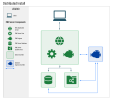Distributing FME Server Components
You can distribute the components of an FME Server installation to achieve an n-tier architecture. Both 2-tier and 3-tier configurations are supported:
Mouse-over for diagram:
In a 2-tier architecture, an Apache Tomcat web application server runs the FME Server Web Services, and is installed alongside the the FME Server Core and FME Engines. Only the FME Server Database is installed separately, along with a remote file system for the FME Server System Share.
Installing the web application server on the same host machine as the FME Server Core is the recommended architecture for a distributed installation.
A 3-tier architecture separates the web application server to another host machine, splitting the presentation and application tiers.
In a 2- or 3-tier scenario, you can provide and manage the following components:
-
The web application server provided by the installer is Apache Tomcat. Optionally, you can provide your own web application server, instead of using the one shipped with the installer.
-
The FME Server Database can be hosted on a PostgreSQL database server provided by the installer, or you can configure the database on your own server using PostgreSQL, Microsoft SQL Server or Oracle. If using an Oracle database server, you must obtain the Oracle Database JDBC Driver.
- A remote file system to host the FME Server System Share, which includes Repositories and Resources.
Recommended 2-tier Architecture
This diagram demonstrates the recommended 2-tier architecture, with the web application server, FME Server Core, and FME Engines running on the same host, and separate servers for the FME Server Database and FME Server System Share. Optionally, you can add FME Engines on a Separate Machine.
Mouse-over for diagram:
Implementing a Distributed Architecture
Perform a distributed installation of FME Server according to the 2-tier or 3-tier procedure:
Or, after an Express installation, perform the following reconfigurations, where necessary:

